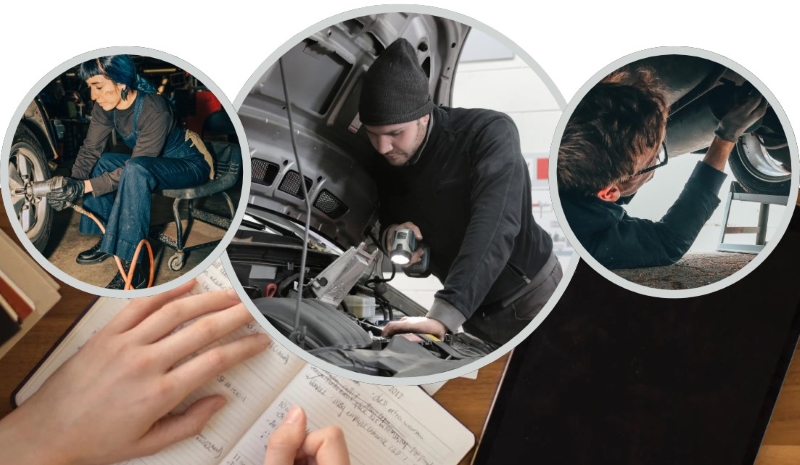Car Buying Scams: How to Avoid Vehicles with Hidden Liens
/by vinaudit
Buying a used vehicle can be a smart financial move—but it can also expose you to hidden risks if you’re not careful. One of the most common threats in the used car market is purchasing a car with an active lien. A lien means someone else, usually a lender, has a legal claim to the vehicle. If that debt isn’t paid, you could lose the car—even if you bought it in good faith.
Imagine buying a used truck in Winnipeg from a private seller who insists the vehicle is “fully paid off.” You trust their word and skip the lien check. A few weeks later, a lender reaches out claiming there’s still an active loan on the vehicle. Now, you’re left dealing with legal complications—and at risk of losing both your truck and the money you paid. A simple Manitoba lien check could have revealed the issue before you made the purchase. Similar risks apply in other Manitoba cities like Brandon, where private sales are also common.
This guide will show you how to spot the warning signs, avoid scams, and protect yourself from buying a car with hidden financial baggage.
What Is a Hidden Lien on a Vehicle?
A hidden lien is a financial claim that isn’t immediately visible or disclosed during a private car sale. It may be tied to an outstanding auto loan, an unpaid repair bill (mechanic’s lien), or fees from an impound lot. If the lien isn’t cleared before the sale, the new buyer could become responsible—or worse, have the car repossessed by the lienholder.
Why hidden liens are a serious problem
Here are the risks of undisclosed lien:
- Legal ownership issues: The seller may not have the full legal right to sell the car.
- Repossession risk: The lender or lienholder can repossess the vehicle if the debt isn’t paid.
- Title transfer delays: You may not be able to register the vehicle in your name until the lien is removed.
- Unexpected costs: You might be forced to pay off the previous owner’s debt just to keep the car.
Common Car Buying Scams Involving Liens
Unfortunately, not every used car sale is straightforward. Some dishonest sellers use deceptive tactics to offload vehicles with active liens. Recognizing these common scams can help you avoid becoming a victim and losing your money—or your new car.
- Seller hides the lien: The seller doesn’t disclose the existence of a lien or falsely claims it has already been paid off. In some cases, they promise to settle the balance after receiving your payment—leaving you at risk if they don’t follow through.
- Forged title: The seller presents a doctored or outdated title that looks clean, but the lien is still active in the official registry. Without verifying the VIN through a trusted source, you might unknowingly buy a vehicle with financial claims attached.
- Quick cash offers: The seller pushes for a fast sale, often with a discounted price, to pressure you into paying before you can check the lien status. These scams rely on urgency to prevent buyers from doing due diligence.
- Disappearing seller: Once the transaction is complete, the seller becomes unreachable—ignoring calls and messages. If a lien surfaces after the sale, there’s no one to hold accountable, and you could be left dealing with the consequences alone.
How to Protect Yourself from Hidden Liens
The good news is that protecting yourself from lien-related scams is entirely possible. With a few smart steps and a cautious approach, you can dramatically reduce the risk of buying a car with unresolved debt attached to it.
- Always run a VIN check: Use a verified service to check for active liens using the vehicle’s VIN before purchasing.
- Ask to see the title: A clean title in the seller’s name without lienholder information is a good sign—but still verify.
- Confirm with the registry: Contact your provincial or state motor vehicle registry to ensure there are no active liens.
- Never pay in full upfront: Delay final payment until you’re 100% certain the lien is cleared.
- Use escrow or a lienholder meeting: If a lien exists, arrange to pay the lienholder directly to ensure it’s resolved.
What to Do If You Discover a Lien After Purchase
Finding out there’s a lien on a car you’ve already bought is stressful—but you still have options. Try contacting the seller or lienholder to resolve the issue. If the seller acted fraudulently, consider reporting the case or seeking legal advice. For a step-by-step guide on resolving liens, read our full guide to removing a lien.
Conclusion
Hidden liens are one of the most damaging and common car buying scams in the used vehicle market. But with the right precautions—especially checking the vehicle’s VIN before buying—you can avoid getting scammed and ensure you’re buying a car with a clear title.
Start with a quick search using the VinAudit Canada lien lookup tool. Run a vehicle lien check today to avoid costly surprises tomorrow.
What to Do If a Used Car Has a Lien: Complete Guide
/by vinaudit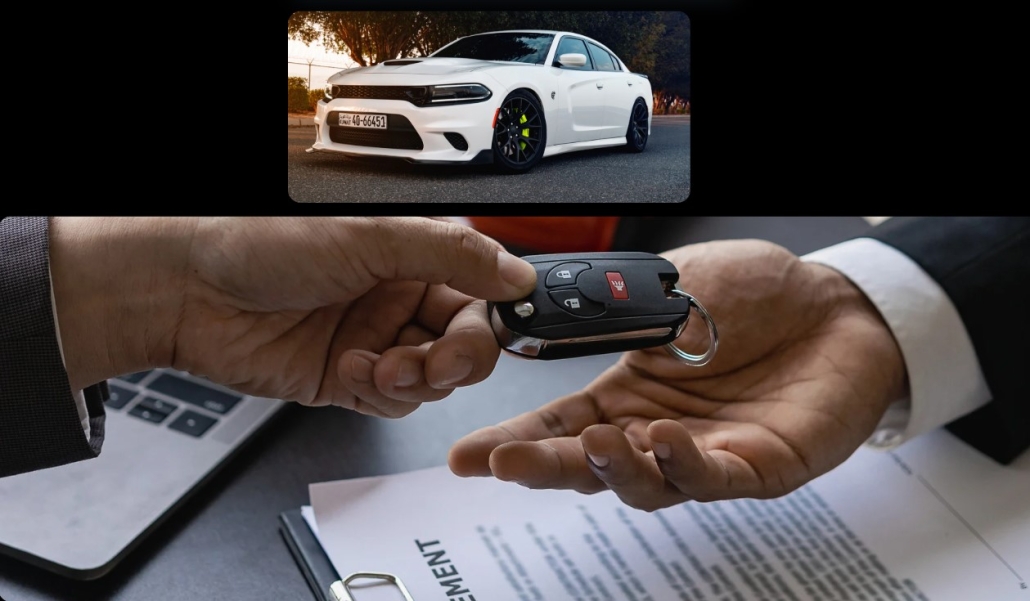
When buying or selling a used vehicle, one of the most important steps is checking for and clearing any existing liens. A lien means someone else—usually a lender or service provider—has a financial claim to the car. Failing to deal with it properly can lead to legal trouble, delays in ownership transfer, or even repossession. This guide walks you through how to check for and remove a lien, so your transaction is smooth and secure.
What is a Car Lien?
A lien is a legal right or claim against a vehicle, typically used as collateral to secure a debt. Until the debt is repaid in full, the lienholder has a legal interest in the car.
- Auto loan lien: When a car is financed, the lender places a lien on the title.
- Mechanic’s lien: Filed by a repair shop when unpaid work or storage fees accumulate.
- Impound lien: May arise when a vehicle is impounded and storage fees remain unpaid.
If a lien remains, the car cannot be legally sold or transferred without resolving it.
How to Check if a Car Has a Lien
Before buying a used car—or selling one—it’s critical to confirm its lien status. Here are common methods to check:
- VIN search: Use the vehicle’s VIN to run a lien check through official government services or third-party providers.
- Provincial or state registries: In Canada, check the Personal Property Security Registration (PPSA) system. In the U.S., consult your state’s DMV or title agency.
- Online services: Tools like VinAudit Canada’s lien check offer fast access to lien data using the VIN.
Example: Running a Lien Check in Ontario
If you’re buying a used car in cities like Toronto or Ottawa, you can perform an Ontario lien search through official PPSA services or use a trusted third-party tool. For a fast and convenient option, try the VinAudit Ontario Lien Check, which allows you to search by VIN and instantly verify if a vehicle has an active financial claim. This can help you avoid buying a car with hidden debt or restrictions on title transfer.
Steps to Clear a Lien on a Used Car
1. Contact the Lienholder
Reach out to the financial institution, service provider, or garage that holds the lien. Ask for the current balance, known as the “payoff amount,” and instructions for settling it.
2. Pay Off the Debt
Once you have the payoff amount, complete the payment using the method approved by the lienholder. Make sure to keep records of the transaction.
3. Obtain a Lien Release Letter
After payment, request a lien release letter. This document should include:
- Vehicle Identification Number (VIN)
- Lienholder’s name and signature
- Date of payoff confirmation
- Statement that the debt has been satisfied
4. Submit Lien Release to the Registry
Take the lien release letter to your local motor vehicle registry (DMV or provincial office) to update the vehicle’s title. This step officially removes the lien from the public record and clears the title.
Clearing a Lien When Buying a Car
Buying a car with an active lien can be risky, but it’s manageable with the right steps:
- Meet the seller and lienholder together: Arrange to pay off the lien directly to the lender and have the lien released immediately.
- Use a secure payment method: Escrow services or bank-managed transactions add protection.
- Hold off on full payment: Avoid paying the seller in full until the lien is confirmed cleared and the title is released.
Special Situations
Lienholder Out of Business
If the lienholder is no longer operating, contact your province or state registry for next steps. You may need a court order or additional documentation to clear the title.
Disputed or Forgotten Liens
If a lien shows up unexpectedly during a title check, request supporting documentation. If it was recorded in error, you may be able to file a lien dispute or request correction.
Tips for Sellers
- Clear the lien before listing: A clean title makes the sale faster and more attractive to buyers.
- Keep your records: Store a copy of the lien release in case of future disputes.
- Disclose the history: Even if a lien is cleared, transparency builds buyer trust.
Tips for Buyers
- Always check the VIN: Run a lien check before any money changes hands.
- Verify documentation: Ask to see the lien release or title showing no active lien.
- Double-check with the registry: Confirm with your local registry that the title is lien-free before registering the car.
Conclusion
Clearing a lien from a used car is essential for a smooth transfer of ownership. Whether you’re a seller preparing to list your vehicle or a buyer double-checking its history, understanding the lien process helps you avoid legal headaches and financial surprises.
Before making your next move, consider running a comprehensive lien check using your vehicle’s VIN. Services like VinAudit Canada make it quick and easy to verify a car’s lien status.
Driving Safely During Heavy Rain or Flooding
/by vinaudit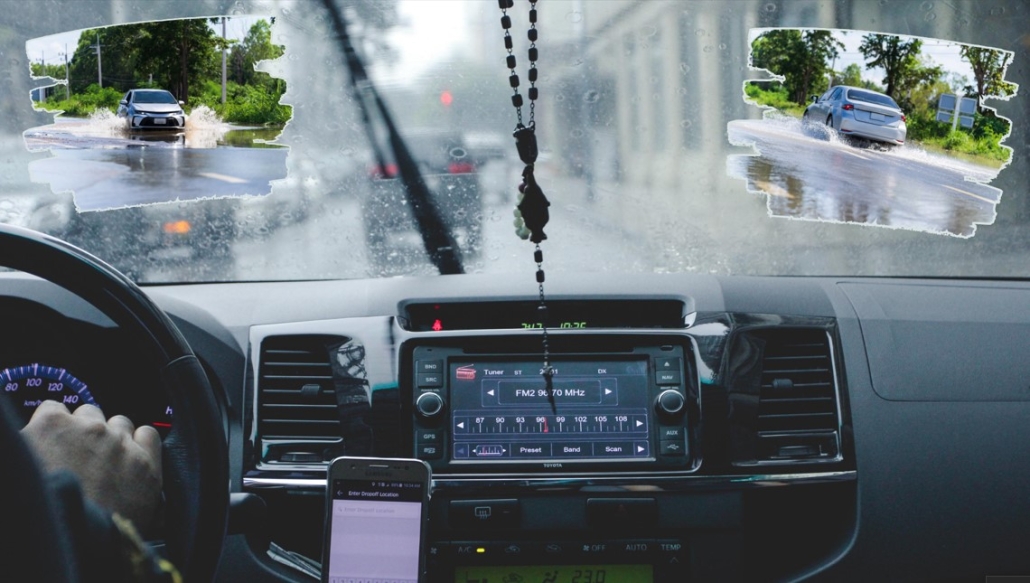
Driving in heavy rain or flooding presents serious risks that demand extra caution. Wet roads reduce traction, visibility decreases, and flooded areas can become deadly traps for unprepared drivers. Whether you’re caught in a sudden downpour or navigating waterlogged streets, knowing the right safety measures can help protect you and others on the road. This guide covers essential tips for driving in adverse weather, avoiding hydroplaning, handling flooded roads, and even purchasing a used car with no history of flood damage.
In Canada, severe weather varies by region and season. Heavy rain and flooding are common in British Columbia, especially during fall and winter due to atmospheric rivers. The Atlantic provinces, including Nova Scotia and New Brunswick, often experience heavy rainfall and storm surges during hurricane season in late summer and early fall. Meanwhile, Ontario and Quebec can face intense downpours in spring and summer, increasing the risk of flash floods. Understanding the weather risks in your area can help you prepare for safe driving.
Understanding the Risks of Driving in Heavy Rain and Floods
Bad weather increases the likelihood of accidents due to several factors:
- Reduced Visibility: Heavy rain can impair sightlines, making it difficult to see road signs, vehicles, and pedestrians.
- Hydroplaning Risk: When tires lose contact with the road due to excess water, drivers may lose control of their vehicle.
- Flood Hazards: Flash floods can occur unexpectedly, submerging vehicles and causing life-threatening situations.
- Extended Stopping Distances:Wet roads from rain or melting snow reduce traction, making it harder to stop quickly. In snowy or icy conditions, the risk is even greater — learn more about safe driving in snow.
Understanding these dangers is key to adjusting driving habits for safety.
Essential Safety Tips for Driving in Heavy Rain
1. Prepare Your Vehicle
Before hitting the road in rainy weather, ensure your car is in optimal condition:
- Check Tires: Adequate tread depth and proper inflation improve grip on wet surfaces.
- Inspect Wipers & Defoggers: Functional wipers clear rain from the windshield, while defoggers prevent interior fogging.
- Test Headlights & Taillights: Visibility decreases in rain, so ensure all lights are operational.
2. Adjust Your Driving
Modifying your driving behavior in wet conditions can prevent accidents:
- Slow Down: Reducing speed minimizes the chance of hydroplaning and allows for better reaction time.
- Increase Following Distance: Leave extra space between you and the vehicle ahead to allow for longer stopping distances.
- Turn Off Cruise Control: Manually controlling speed gives you better handling on slippery roads.
- Use Low Beams: High beams reflect off raindrops, reducing visibility—stick to low-beam headlights.
3. Avoid Hydroplaning
Hydroplaning occurs when a vehicle skids on water rather than making contact with the road. Prevent this by:
- Driving at Moderate Speeds: The faster you go, the higher the risk of hydroplaning.
- Avoiding Sudden Braking or Steering: Abrupt movements can cause loss of control.
- Choosing the Right Lane: Water tends to accumulate in outer lanes—stay in the middle when possible.
- If Hydroplaning Happens: Ease off the accelerator and steer in the direction you want to go—do not slam on the brakes.
Navigating Flooded Roads Safely
1. Assessing Water Depth Before Entering
Driving through floodwater can be extremely dangerous. Consider the following:
- Avoid Deep Water: If water reaches halfway up your tires, it is too deep to drive through safely.
- Know the Risks: Just six inches of water can cause loss of control, and one foot can sweep a vehicle away.
- Turn Around If Unsure: Never assume a flooded road is safe—seek alternative routes.
2. Safe Driving Through Standing Water
If no other route is available, follow these precautions:
- Proceed Slowly: Maintain a steady, slow speed to avoid creating a wake.
- Stick to Higher Ground: Stay in the center of the road where water is usually shallower.
- Test Your Brakes After Crossing: Apply light pressure to dry them out.
3. What to Do If You’re Trapped in a Flooded Car
Floodwaters can rise quickly, so knowing how to react is crucial:
- Stay Inside If Water Is Not Rising Rapidly: Do not exit unless necessary.
- Unbuckle and Open a Window: Rolling down a window before power fails provides an escape route.
- If Sinking, Exit Immediately: A submerged vehicle can be deadly—get out as quickly as possible.
- Avoid Moving Water: Never attempt to drive through fast-moving floodwaters.
Emergency Preparedness for Adverse Weather
Being proactive can make all the difference when caught in bad weather. Having the right supplies and information can help prevent accidents or ensure a quick response in case of emergencies.
1. Pack an Emergency Kit
Always keep an emergency kit in your vehicle, especially during seasons prone to heavy rain and flooding. Your kit should include:
- Flashlight and extra batteries: Essential for nighttime visibility in case of a breakdown.
- First-aid supplies: Bandages, antiseptics, and pain relievers for minor injuries.
- Bottled water and non-perishable snacks: Useful if stranded for an extended period.
- Phone charger and backup power source: Ensure your phone remains charged for emergency calls.
- Jumper cables and basic tools: Useful for vehicle-related emergencies.
- Blanket and extra clothing: Helps keep warm in case of unexpected delays.
2. Stay Informed
Knowing the latest weather conditions before heading out can help you make safer travel decisions. Take these precautions:
- Check weather updates: Use a weather app or listen to local news for road conditions and flood warnings.
- Be aware of high-risk areas: Some roads and underpasses are prone to flooding—plan routes accordingly.
- Follow official warnings: If authorities advise against travel, avoid unnecessary risks.
3. Plan Alternate Routes
Unexpected road closures due to flooding or accidents can disrupt travel plans. Be prepared by:
- Identifying backup routes: Know multiple ways to reach your destination in case of detours.
- Using GPS with real-time updates: Traffic and weather apps can help navigate around roadblocks.
- Informing someone of your travel plans: Let family or friends know your route and estimated arrival time.
4. Keep Your Fuel Tank Full
Severe weather can lead to unexpected delays or detours. Keeping your gas tank at least half full ensures:
- You’re not stranded: Running out of fuel in bad weather can put you at risk.
- Fuel line protection: In colder temperatures, a full tank prevents fuel line freezing.
How to Buy a Used Car with No History of Flood Damage
Flood-damaged vehicles often make their way into the used car market, and purchasing one unknowingly can lead to costly repairs and serious safety concerns. Follow these steps to ensure you’re not buying a car with hidden flood damage.
1. Check the Vehicle’s History Report
A vehicle history report can reveal if a car has been in a flood. Use a VIN check service like VinAudit Canada to access:
- Previous flood damage records: Look for reports indicating the car was submerged or written off by insurance.
- Title status: Avoid vehicles with a “salvage” or “rebuilt” title, as they may have sustained flood damage.
- Registration history: Cars previously registered in flood-prone areas should be inspected more carefully.
2. Inspect for Signs of Water Damage
Physical inspection can help uncover hidden flood damage. Pay attention to these warning signs:
- Musty or damp odors: A moldy smell inside the car suggests water exposure.
- Water stains and rust: Check under the seats, in the trunk, and around bolts for rust or discoloration.
- Damp carpets and upholstery: Run your hand along the carpet and trunk lining for moisture.
- Foggy headlights or dashboard condensation: Water trapped inside lights and gauges is a red flag.
3. Have a Mechanic Perform an Inspection
Before finalizing a purchase, have a professional mechanic check for hidden damage, focusing on:
- Electrical systems: Water exposure can lead to long-term electrical issues.
- Brakes and suspension: Flood-damaged vehicles may have rusted or malfunctioning brake systems.
- Undercarriage and engine: Inspect for signs of dried mud, rust, or debris in hard-to-reach areas.
4. Be Cautious of Deals That Seem Too Good to Be True
Scammers often sell flood-damaged cars at suspiciously low prices. Protect yourself by:
- Researching market prices: Check if the deal seems much lower than the average, verify market value estimate.
- Verifying seller credibility: Buy from reputable dealers or individuals with a proven history.
- Avoiding pressure tactics: If a seller pushes for a quick sale, be extra cautious.
Key Takeaways
Driving in heavy rain and floods demands caution, preparation, and adaptability. Proactive steps can help prevent hydroplaning, avoid hazards, and ensure safety.
- ✔️ Adjust your driving habits.
- ✔️ Avoid flooded roads whenever possible.
- ✔️ Be prepared for emergencies.
- ✔️ Inspect used cars carefully before purchasing.
Stay informed, drive safely, and always prioritize caution over convenience in hazardous weather.
Best Car to Buy Based on Color and Resale Value
/by vinaudit
Does Car Colour Affect Resale Value?
Many car buyers focus on make, model, and features, but colour can also play a significant role in resale value. Some colors hold their value better due to higher demand, easier maintenance, and buyer preferences. On the other hand, less common colors may appeal to a niche market, potentially affecting how quickly a car sells.
Market trends show that white remains the most popular car colour in Canada, while black and blue have been increasing in demand. Meanwhile, silver has seen a decline in popularity over the years. Interestingly, studies suggest that orange and yellow vehicles often depreciate less due to their lower supply, meaning sellers may have stronger bargaining power when trading in or reselling.
This guide explores how car colour impacts resale value, which colors perform best in the used car market, and how to choose a shade that balances personal preference with long-term value.
How Car Colour Affects Resale Value
Car colour plays a bigger role in resale value than many people realize. Several factors contribute to how colour influences pricing and demand in the used car market.
- Market demand: Popular colors like white, black, and gray are widely available and easier to sell.
- Supply and competition: Common colors face more competition, while unique colors like orange and yellow can command higher trade-in values due to lower availability.
- Perceived value and style: Bright colors are often associated with sports cars and high-performance vehicles, making them more desirable in specific segments.
- Regional trends: Climate and location influence colour choices, with lighter colors being more popular in warmer areas due to heat resistance.
Choosing a car colour isn’t just about aesthetics—it affects how much you can sell or trade the vehicle for later. Understanding these factors helps buyers and sellers make informed decisions.
Best Car Colors for Resale Value in Canada
When it comes to resale value, some colors consistently outperform others. These colors tend to hold their value well and attract more potential buyers when it’s time to sell.
- White: The most popular colour in Canada due to its timeless appeal, ease of maintenance, and strong demand in the used car market.
- Black: A rising favorite, especially for luxury vehicles, though it requires frequent cleaning as it shows scratches and dirt more easily.
- Gray/Silver: Previously the most popular choice, still considered practical and neutral, making it a safe option for resale.
- Blue: Increasing in popularity, particularly darker shades, as they provide a sleek look without being as common as black or white.
- Orange and Yellow: Studies suggest these colors depreciate less due to lower supply, meaning buyers seeking these shades have fewer options, increasing demand.
While neutral colors dominate the used car market, brighter colors can still perform well in specific vehicle categories, such as sports cars and off-road models.
Worst Car Colors for Resale Value
While some car colors hold their value well, others tend to depreciate faster due to limited demand. Uncommon or polarizing colors may take longer to sell, as they appeal to a smaller group of buyers.
- Brown and Gold: Often considered outdated, these colors have lower demand in the used car market, making resale more difficult.
- Purple and Green: While unique, these colors do not appeal to the majority of buyers, limiting their resale potential.
- Bright Yellow and Orange (for some models): Although studies suggest these colors retain value well in niche markets, they can be harder to sell for standard sedans and family vehicles.
Choosing one of these colors does not mean your car will not sell, but it may take longer to find the right buyer. If resale value is a priority, selecting a more widely accepted colour is the safer choice.
Choosing the Best Car Colour for Long-Term Value
Picking a car colour is a balance between personal preference and long-term resale value. While bright and unique colors may stand out, neutral tones typically offer better resale potential.
- Consider market trends: White, black, and blue continue to be the most popular choices in Canada.
- Think about competition: Unique colors may command higher prices but can take longer to sell.
- Factor in maintenance: Darker colors show dirt and scratches more easily, while lighter colors require less frequent cleaning.
- Match the colour to the vehicle type: Sporty and performance cars can benefit from bold colors, whereas sedans and SUVs sell better in neutral tones.
Considering these factors helps buyers make informed decisions that balance style, maintenance, and future resale potential.
Real-World Scenarios: How Car Color Affects Resale Value
Understanding how car color impacts resale value can help both buyers and sellers make smarter decisions. Here are some real-world examples where color plays a key role in pricing and market demand.
(Scenario 1) Selling a Car with a Unique Color: Emma owns a bright yellow sports car and is concerned about resale value. She discovers that, while yellow cars typically depreciate less, they also have a smaller pool of buyers. She decides to list the car on specialty platforms where buyers actively search for sports cars in rare colors, helping her secure a competitive price.
(Scenario 2) Choosing the Right Color for a Family Vehicle: David is buying a new SUV and plans to keep it for five years before trading it in. He considers a deep green model but notices that white, black, and silver SUVs sell faster in his area. To maximize resale value, he chooses a neutral color, ensuring a quicker sale when he decides to upgrade.
Scenario 3) Trade-In Offer Affected by Color: Sophie is trading in her brown sedan at a dealership. The dealer offers her a lower price than expected, explaining that brown sedans take longer to sell. Realizing that a more popular color would have retained its value better, she decides to negotiate or explore private sale options.
Conclusion: The Smartest Color Choice for Resale Value
While personal preference plays a role in selecting a car color, resale value should not be overlooked. Some colors consistently perform better in the used car market, making them safer choices for long-term value.
White remains the safest bet for resale due to its ongoing popularity and ease of maintenance, while black and blue are gaining traction. If resale value is a priority, sticking to high-demand, neutral colors is the best strategy.
Bright and unique colors can still perform well in niche markets, but they may require more time to find the right buyer. Ultimately, the best choice depends on a balance between individual taste and market demand.
Getting the Best Car Appraisal When Buying or Selling in Canada
/by vinaudit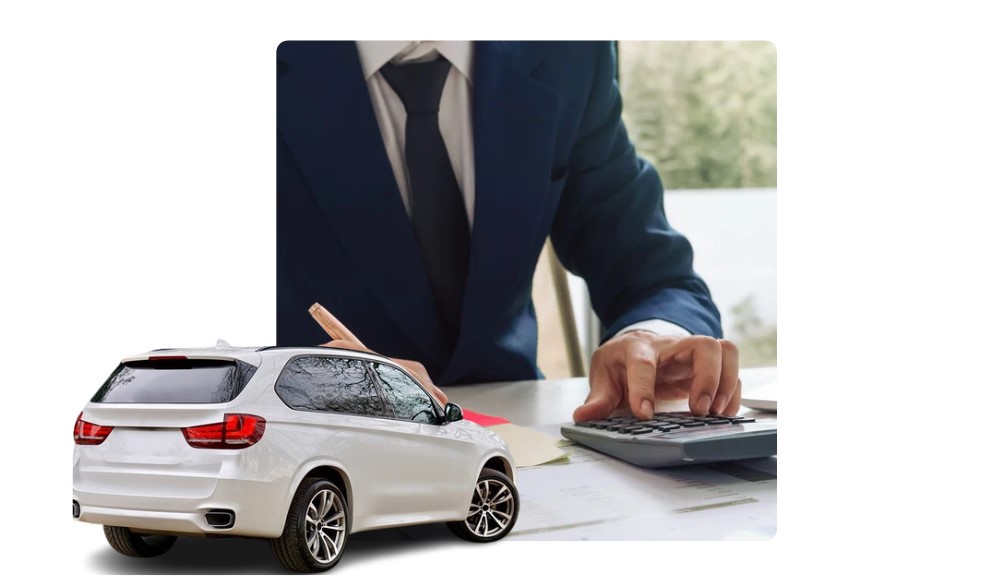
Why a Car Appraisal Matters
Whether you’re buying, selling, or trading in a car, an accurate appraisal ensures you get the best deal. While book values provide a starting point, they don’t always reflect real-world pricing. Many valuations are based on listing prices rather than actual sales, meaning the value of a car can vary significantly depending on market conditions.
A proper appraisal should consider more than just advertised prices. Factors such as accident history, past ownership, and odometer readings all influence a vehicle’s true worth. Ignoring these details can lead to overpaying as a buyer or underpricing as a seller.
Using a combination of market valuation tools, vehicle history reports, and professional inspections can help determine a more accurate price. This guide outlines the key elements of a thorough appraisal process and how to ensure fair pricing for both buyers and sellers.
The Three Pillars of an Accurate Car Appraisal
Appraising a vehicle correctly requires considering three key factors. Relying solely on book values may not reflect actual selling prices, so it’s important to evaluate a car based on real market conditions.
Market-Based Pricing vs. Actual Sales: Book values are often based on listings rather than final sales. Since sellers typically list vehicles at a higher price expecting negotiation, the final transaction price can be much lower. To get a more realistic appraisal, use tools like VinAudit Canada’s Market Value Tool, which compares similar vehicle sales in your area.
Impact of Car History on Value: Two identical vehicles can have vastly different values depending on their history. Accidents, past ownership records, and odometer readings all affect a car’s worth. A history-based valuation, available through the VinAudit Canada Vehicle History Report, adjusts pricing based on a vehicle’s specific background.
Physical Condition & Mechanical Health: A car’s exterior and interior condition significantly influence its appraisal value. Rust, dents, interior wear, and past repairs can lower a vehicle’s market price. While visual inspections help, a pre-purchase inspection by a certified mechanic ensures past repairs were completed properly and identifies potential mechanical issues that may not be immediately visible.
Appraising a Car for Different Situations
The reason for appraising a car can influence how its value is assessed. Whether selling, buying, or trading in, understanding the factors that impact pricing helps ensure a fair deal.
Selling Your Car: Maximizing Value
Setting the right asking price is key to attracting buyers without undervaluing your vehicle. Overpricing can discourage interest, while underpricing results in a lower return.
- Research comparable listings in your area to determine a competitive price.
- If your car has a clean history, highlight this, as only a fraction of vehicles remain accident-free.
- For cars with prior damage, use an appraisal tool to adjust pricing accordingly and build buyer trust.
- Providing service records and a vehicle history report reassures potential buyers about the car’s condition.
Buying a Used Car: Ensuring Fair Pricing
As a buyer, a proper appraisal prevents overpaying and ensures the vehicle is worth its price. A listing price does not always reflect the car’s actual value.
- Compare real sales data rather than relying solely on book values.
- Check for accident history, liens, and odometer discrepancies using a history-based appraisal.
- Avoid sellers who refuse to provide a vehicle history report, as transparency is key to a safe purchase.
- Consider a pre-purchase inspection to verify past repairs and detect potential mechanical issues.
Trading in Your Car: Understanding Dealer Appraisals
Trade-in values differ from private sales due to dealership resale costs. Knowing how dealers calculate offers helps set realistic expectations.
- Dealers adjust pricing based on reconditioning costs, location, and market demand.
- A well-maintained vehicle with service records may receive a higher offer.
- Trade-ins can reduce taxes on a new vehicle purchase in some provinces, making them financially beneficial.
- Before accepting a trade-in offer, compare it with private sale estimates to determine the best option.
The Smart Way to Get an Accurate Car Appraisal
A well-rounded appraisal requires more than just checking a price guide. Combining different evaluation methods helps ensure accuracy and fair pricing.
- Check market value: Use VinAudit Canada’s Market Value Tool to compare recent sales of similar vehicles in your area.
- Get a history-based valuation: A vehicle history report accounts for past accidents, mileage, and ownership history to refine pricing.
- Inspect the car’s condition: Cosmetic wear, mechanical issues, and maintenance history can raise or lower value beyond standard pricing estimates.
- Cross-check multiple sources: Compare book values, dealership offers, and private sale listings for a balanced view.
Real-World Scenarios: How Car Appraisals Impact Decisions
Understanding how car appraisals work can make a big difference in real-world situations. Here are three common scenarios where accurate valuations play a crucial role:
Scenario 1: Selling a Car with Accident History
Emma wants to sell her used sedan but discovers it has a past accident on its record. She checks the book value and realizes it doesn’t reflect her car’s history. Using a history-based appraisal, she adjusts her price to account for the previous damage while highlighting recent repairs. This transparency builds trust with buyers and helps her sell the car at a fair price.
Scenario 2: Negotiating a Better Trade-In Offer
David plans to trade in his SUV at a dealership. The dealer’s initial offer seems low, so he cross-checks with a market value tool and presents his vehicle’s service records. Seeing the car’s well-maintained condition, the dealer improves the offer, saving David hundreds of dollars.
Scenario 3: Avoiding Overpaying for a Used Car
Sophie finds a used car listing that looks like a great deal. Before purchasing, she checks its vehicle history and discovers undisclosed mileage discrepancies. With this information, she either negotiates a lower price or walks away from a risky purchase.
Conclusion: Why Appraisals Should Never Be One-Dimensional
A proper car appraisal is more than just a number—it’s a combination of market demand, history, and vehicle condition.
An accurate car appraisal isn’t just about what a car is listed for—it’s about what it has been through, how it has been maintained, and how it compares to actual sales in the market.
- For sellers: Pricing competitively ensures your car gets attention while maximizing returns.
- For buyers: Verifying an appraisal prevents overpaying for a vehicle that may have hidden issues.
- For trade-ins: Understanding how dealerships assess value helps in negotiating a fair offer.
By using a mix of market data, history-based reports, and professional inspections, you can confidently navigate any car appraisal situation and secure the best deal.
How to Buy a Used Car Safely (Guide)
/by vinaudit
Buying a used car is a smart way to save money, but it requires careful planning to avoid potential risks. Unlike new cars, used vehicles may have hidden mechanical issues, accident history, or legal complications. Without proper research, buyers risk purchasing a car with costly repairs, outstanding liens, or fraudulent documentation.
To ensure a safe transaction in Canada, it’s essential to verify the car’s history, inspect its condition, and complete all legal paperwork correctly. This guide walks you through the key steps—budgeting, researching, inspecting, and finalizing the deal—to help you make an informed decision.
Whether buying from a dealership or a private seller, taking the right precautions can prevent scams and unexpected problems. By following this guide, you can confidently purchase a used car that is reliable, fairly priced, and free from hidden surprises.
1. Set Your Budget and Financing Options
Before searching for a used car, set a budget that includes not just the purchase price but also taxes, registration fees, insurance, and maintenance costs. Overlooking these expenses can lead to financial strain.
Financing vs. Cash Purchase:
- Paying in Cash: No interest fees, better negotiation power.
- Financing: Monthly payments but added loan costs.
If financing, getting pre-approved for an auto loan ensures better interest rates and a clearer budget. Compare lenders and avoid long-term loans that increase overall costs.
Also, consider the cost of ownership and market value for a thorough evaluation. Factors such as depreciation, insurance, taxes, fuel, and repair costs contribute to the total ownership cost.
2. Research the Right Car for Your Needs
Choosing the right car requires balancing budget, reliability, and practicality. Start by defining your needs:
- Daily commute or family use? Fuel efficiency vs. space.
- City or highway driving? Compact cars vs. sedans/SUVs.
- Essential features? Safety ratings, infotainment, comfort.
Compare models based on reliability, resale value, and maintenance costs using trusted sources like Consumer Reports or Kelley Blue Book.
When searching, check dealership listings, private sellers, and online platforms for competitive pricing. Look for a detailed vehicle description, service history, and VIN availability. Avoid listings with vague details, stock photos, or unrealistic pricing.
Before making an offer, use a car valuation tool to ensure fair market pricing. Thorough research prevents regret and helps you find a dependable used car.
3. Verify the Car’s History and Condition
Before purchasing a used car, checking its history and physical condition is essential. A vehicle may look good on the outside but could have hidden problems that may lead to costly repairs.
- Get a Vehicle History Report: Obtain a report to check for past accidents, title issues, odometer rollbacks, and liens. Services like VinAudit Canada can provide this information quickly.
- Inspect the Vehicle: Look for signs of rust, uneven paint, dents, or frame damage. Inside, check for wear and tear on seats, dashboard warning lights, and working electronics.
- Have a Mechanic Inspect the Car: A professional inspection can uncover mechanical issues that aren’t immediately visible. This step is crucial, especially for private sales.
4. Test Drive the Vehicle
A test drive is one of the most critical steps in evaluating a used car. It helps assess how the car handles and whether there are any mechanical issues.
- Drive in Different Conditions: Test the car on city streets and highways. Pay attention to acceleration, braking, and how the car handles turns.
- Listen for Unusual Noises: Strange sounds from the engine, brakes, or suspension could indicate problems.
- Check the Dashboard: Warning lights should not remain on after starting the vehicle. If they do, it may indicate an underlying issue.
- Test Essential Features: Ensure the lights, air conditioning, wipers, and infotainment system are functioning properly.
5. Check the Title and Ownership Documents
Ensuring that the car’s title and ownership documents are legitimate is key to avoiding scams or legal issues.
- Verify the Title Status: The title should be clean, meaning it is not branded as salvage or rebuilt. A salvage title indicates significant past damage.
- Confirm the VIN Matches: The Vehicle Identification Number (VIN) on the title should match the one on the car. Any discrepancies could signal fraud.
- Check for Liens: A lien means the car may still have an outstanding loan. Ensure the seller provides proof that all debts have been cleared.
- Ask for Maintenance Records: A well-documented service history suggests proper care and upkeep of the vehicle.
6. Negotiate the Price and Finalize the Deal
Once you’ve found the right car, negotiating the price ensures you get a fair deal. Be prepared with research and confidence when discussing pricing with the seller.
- Research fair market prices: Use pricing tools like Kelley Blue Book or Edmunds to determine a reasonable price based on the car’s make, model, mileage, and condition.
- Make an offer based on the vehicle’s condition: Consider any repairs needed and factor them into your negotiation. If the seller is unwilling to budge, be prepared to walk away.
- Ensure all agreements are documented in writing: Get a bill of sale with the agreed-upon price, VIN, and both parties’ signatures. If buying from a dealership, review the contract for additional fees.
7. Complete the Registration and Insurance Process
Before legally driving your newly purchased vehicle, you must complete the necessary registration and insurance steps.
- Transfer the title and register the vehicle: Complete the title transfer at your local Department of Motor Vehicles (DMV) or equivalent agency. Ensure all fees and taxes are paid.
- Obtain necessary insurance coverage: Most states and provinces require valid auto insurance before registration. Contact your provider to set up coverage before driving.
- Comply with local inspection requirements: Some regions require emissions or safety inspections before registration. Check your local regulations to ensure compliance.
8. Avoid Common Scams and Red Flags
Scams are common in the used car market. Being aware of red flags can help you avoid fraudulent sellers and bad deals.
- Be cautious of deals that seem too good to be true: Extremely low prices may indicate hidden damage, odometer fraud, or a stolen vehicle.
- Avoid sellers who pressure you or refuse inspections: Scammers often rush buyers into making quick decisions without proper checks.
- Use secure payment methods and verify all information: Avoid wire transfers or cash payments without written proof of sale. Verify the seller’s identity and ownership documents.
Conclusion
Making a safe and informed used car purchase requires patience and due diligence at every step.
Buying a used car requires careful research and attention to detail to ensure a safe and satisfactory purchase. Taking the time to inspect the vehicle, verify its history, and follow legal procedures can save you from costly mistakes.
Patience is key—never rush into a deal without conducting thorough checks. Whether buying from a dealer or private seller, always prioritize safety and transparency.
Utilizing reputable resources like vehicle history reports from VinAudit can help confirm a car’s background and provide peace of mind. By following these steps, you can confidently make a well-informed used car purchase.
Vehicle Maintenance Logs: Tracking Car Services and Repairs
/by vinauditA well-maintained vehicle runs more efficiently, lasts longer, and retains its value over time. Every car requires regular servicing, from essential oil changes and tire rotations to more comprehensive brake inspections and engine tune-ups. Keeping up with these tasks can be challenging, especially if you rely on memory or scattered paperwork. However, failing to track maintenance can lead to unexpected breakdowns, costly repairs, and even safety risks on the road.
There are various ways to keep track of maintenance, from traditional logbooks and spreadsheets to mobile apps and VIN-based tracking services. Some modern vehicles even offer built-in digital maintenance tracking. No matter which method you choose, consistently recording your vehicle’s service history is a small effort that yields long-term benefits. A well-documented maintenance log is a valuable tool that enhances vehicle performance, safety, and financial planning.
What Is a Car Maintenance Log and Why Is It Important?
A vehicle maintenance log is a record of your car’s repair and service history, helping you track and schedule routine maintenance. It can include essential tasks such as:
- Oil changes and lubrication
- Tire rotations and replacements
- Brake inspections and repairs
- Battery health checks
- Winterizing and seasonal maintenance
Some of these tasks can be done yourself, while others require a visit to a local service shop. Regardless, keeping a maintenance log ensures that all the important information is stored in one place, making vehicle upkeep easier and more efficient.
By maintaining a structured maintenance log, you can ensure that your vehicle receives timely servicing, avoid duplicate repairs, and stay on top of manufacturer-recommended maintenance schedules. Whether you own a brand-new car, a used vehicle, or a leased automobile, having an organized record helps streamline service scheduling, prevent expensive surprises, and provide documentation for warranty claims, insurance purposes, or future resale.
How to Keep a Vehicle Maintenance Log
There are multiple ways to track your vehicle’s maintenance records, depending on your preference and level of convenience.
1. Manual Methods
- A Logbook or Notebook: Keep a dedicated notebook in your car to record service dates, mileage, and maintenance details.
- Spreadsheets (Microsoft Excel or Google Sheets): A digital spreadsheet allows you to log service records while automatically calculating expenses.
- Organizing Paper Receipts: Keep all service invoices in a folder to have a physical record of maintenance.
2. Digital Tools and Mobile Apps
Several mobile apps and online tools like AUTOsist and Drivvo simplify vehicle maintenance tracking. Some useful features include:
- Automatic reminders for service intervals
- Cloud storage for easy access across devices
- Mileage-based tracking to recommend services
3. Using Your Vehicle’s Onboard System
Many modern cars have built-in maintenance tracking systems that log service history and provide reminders for upcoming maintenance. Features may include:
- Digital service logs accessible from the dashboard
- Automated service reminders based on mileage or time
- Integration with manufacturer-connected services for cloud-based tracking
4. Checking with Your Mechanic or Dealership
If you regularly service your vehicle at a specific repair shop or dealership, they likely maintain records of your car’s past maintenance.
- Request a printout or digital copy of service history
- Check if your dealership offers online access to past services
- Ensure records are updated after every maintenance visit
Keeping a vehicle maintenance log is a simple yet effective way to track repairs, schedule routine services, and extend your car’s lifespan. Whatever you choose for tracking, consistency is key. Choose a method that fits your needs and start recording maintenance details to stay organized and protect your investment.
Do I Still Need a Vehicle History Report?
While a car maintenance log provides valuable records of routine service and repairs, it does not offer a complete picture of a vehicle’s history. VinAudit Canada’s vehicle history report, for example, includes critical details that a maintenance log might not capture, such as:
- Accident History: Records of reported accidents and damage.
- Title Status: Identifies salvage, rebuilt, or lemon titles.
- Theft and Lien Records: Checks for theft reports or outstanding loans.
- Odometer Readings: Detects inconsistencies or possible fraud.
- Ownership and Registration: Tracks previous owners and state registrations.
Limitations of a Maintenance Log
- Limited Coverage: Often includes only dealership or major service center records.
- Missing Accident Data: Does not show accident history unless repairs were reported.
- No Ownership Details: Lacks previous owner or vehicle usage information.
- Gaps in Records: Some services may not be documented.
Even with a maintenance log, a vehicle history report provides a more complete and reliable view of a car’s past, helping buyers make informed decisions.
Best Practices for Keeping Maintenance Records
- Set Reminders: Use your phone, calendar, or a tracking app to remind you of upcoming maintenance.
- Store Physical & Digital Copies: Keep receipts in a folder and upload scanned copies to the cloud for easy access.
- Review Before Trips: Before long road trips, check your records to ensure all essential maintenance is up to date.
- Categorize Records: Organize by time periods (monthly, quarterly, yearly) or by maintenance type (tires, fluids, brakes, etc.).
Conclusion
Tracking your vehicle’s maintenance records is an effective way to stay organized, save money, and maintain your car’s performance. Whether you choose a physical logbook, a spreadsheet, or a mobile app, keeping an updated record ensures your vehicle gets the care it needs.
Even if you haven’t tracked maintenance before, it’s never too late to start. You can begin by gathering past service receipts, noting recent repairs, and using a method that works best for you to maintain future records.
Start tracking your car’s maintenance history today to keep it in top condition for years to come!
How to Find the Best Used Car Online: A Smarter, Safer Approach
/by vinaudit
Shopping for a used car today looks very different than it did a decade ago. Instead of walking onto a dealership lot with little knowledge of pricing or available models, most buyers now start their search online, comparing listings, reading vehicle history reports, and evaluating market trends before ever setting foot in a dealership or meeting a private seller.
With access to online marketplaces, dealership websites, and vehicle history tools, buyers are more informed than ever. They compare models, filter listings by price and features, and even research ownership and accident history. However, with so many options at their fingertips, buyers must also be cautious—hidden issues, misleading ads, and scams are still common in the used car market.
The key to a successful purchase is not just finding the right car, but also knowing where to look, verifying listings, and making informed decisions. Whether purchasing from a dealership or a private seller, understanding how to research, compare, and negotiate can mean the difference between a great deal and a costly mistake. This guide will help you navigate the online car market, ensuring that you find a reliable vehicle at a fair price while avoiding common pitfalls.
Start with Local Dealership Websites
Many dealerships maintain up-to-date online inventories, allowing buyers to browse available cars, check features, and compare prices before visiting in person. Searching through dealer websites has several advantages:
- Convenience – Browse listings outside of dealership hours.
- Better Selection – Some dealerships list vehicles from multiple locations.
- Financing and Trade-In Options – Dealers often provide financing details and trade-in estimates.
Before visiting, check whether the dealer offers a certified pre-owned (CPO) program, which may include warranties and inspections for added peace of mind.
Explore Online Car Listing Platforms
Dedicated online marketplaces make it easy to compare listings from dealerships and private sellers. Some of the top sites include:
- autoTRADER.ca – One of Canada’s largest car marketplaces.
- Kijiji Autos – Offers both dealership and private listings with history report options.
- Auto123.com and Wheels.ca – Feature-rich platforms with reviews and comparisons.
- Craigslist and Facebook Marketplace – Useful for private sales but require caution to avoid scams.
- eBay Motors – Ideal for finding rare models, but consider location and shipping costs.
Run a VinAudit Canada vehicle history report, to check details about past accidents, ownership records, title status, and more.
Do Not Overlook Traditional Classifieds and Newspapers
While national listing sites offer a vast selection, local sources can sometimes lead to better deals on vehicles that may not be widely advertised.
- Community Newspapers – Many city newspapers have an online classified section with local car listings.
- Used Car Buying Guides – Some print auto magazines also publish their listings online.
Use Online Buying Guides and Pricing Tools
Understanding market pricing is key to negotiating the best deal. In addition to browsing listings, buyers should take advantage of online pricing tools and buying guides.
- VinAudit Canada Market Value Tool – Provides pricing insights based on actual vehicle sales data.
- Canadian Black Book and Kelley Blue Book (KBB) – Estimate resale values based on make, model, and condition.
- Vehicle History Reports – Help identify accident history, title status, and previous ownership.
Stay Safe When Buying Online
The convenience of online car shopping also comes with risks. To ensure a safe transaction, buyers should watch out for common warning signs:
- Unrealistically Low Prices – If a deal seems too good to be true, it likely is.
- Sellers Who Refuse to Meet in Person – Always inspect the car before making any payment.
- Requests for Deposits or Wire Transfers – Fraudulent sellers often ask for money upfront.
- Fake Vehicle History Reports – Always get a trusted report from VinAudit Canada.
For added security, meet the seller in a public location, bring a friend or family member, and consider having a mechanic inspect the car before finalizing the purchase.
Final Thoughts: How to Find the Best Used Car Online
Finding a reliable used car requires careful research, patience, and attention to detail. Instead of settling for the first listing that looks promising, take the time to explore different sources, verify vehicle history, and compare pricing.
By browsing dealership websites, listing platforms, and local classifieds, buyers can expand their options and find competitive deals. Using pricing tools and history reports ensures that a car is fairly valued and free of hidden problems. Most importantly, staying cautious and following safety guidelines will help prevent scams and ensure a secure transaction.
Don’t risk buying a car with hidden issues—check its history today! Visit the Reports Section to check what a VinAudit Canada car history report covers.
Car Resale Value: Location & Other Factors at Play
/by vinaudit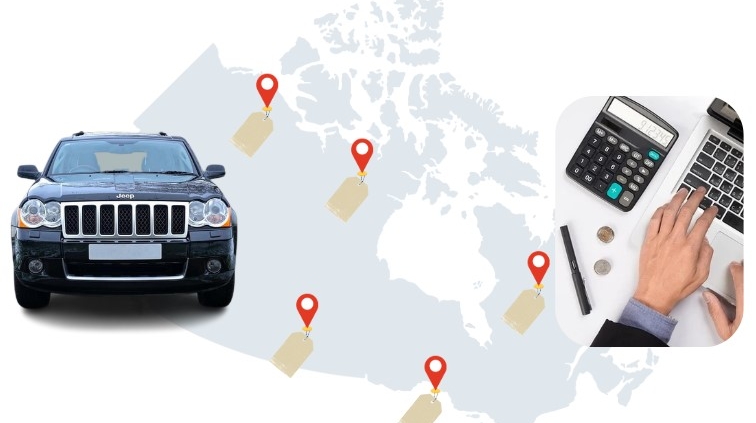
Imagine two identical cars—same model, year, and mileage—but one sells for thousands more than the other. What’s the difference? Location. Where you live in Canada plays a crucial role in determining your car’s resale value, but it’s not the only factor.
Take this real-world example: A used 4×4 truck in Alberta may fetch a high price due to demand from rural and industrial buyers, while the same truck in downtown Vancouver—where compact cars and EVs are preferred—may struggle to sell. Similarly, a convertible in Ontario might sell fast in the summer, but its resale value drops during the colder months.
Beyond location, economic trends, seasonal demand, and vehicle condition also shape resale value. Understanding these factors can help you maximize what you get when selling your vehicle.
How Global Events and Market Trends Affect Resale Value
Impact of Economic Shifts
Major world events and economic trends directly impact the used car market:
- Supply chain disruptions – A shortage of new vehicles increases demand for used cars, raising resale values. When production delays affect the availability of new cars, buyers turn to the used car market, driving up prices for in-demand models.
- Fuel price spikes – High gas prices lead to increased demand for fuel-efficient and electric vehicles. As consumers look to cut fuel costs, hybrid and electric vehicle resale values tend to rise, while gas-guzzling SUVs and trucks may see a drop in demand.
Resale Tip: If you’re selling a fuel-efficient or electric vehicle, consider listing it during a period of high gas prices when demand is strongest. Conversely, if you own a truck or SUV, timing your sale when fuel prices are lower can attract more buyers looking for larger vehicles.
Local Economy and Regional Industry Effects
The economic landscape of a province influences which vehicles hold value.
Province-Specific Vehicle Demand
- Technology hubs (e.g., Toronto, Vancouver) – High demand for electric and hybrid cars due to government incentives.
- Mining & agriculture provinces (e.g., Alberta, Saskatchewan) – Trucks retain higher resale value due to industrial use.
- Suburban and family-oriented regions – SUVs and minivans are more popular in family-friendly communities.
Urban vs. Rural Preferences
In cities with strong public transit, small, fuel-efficient cars have a higher resale value. Meanwhile, in rural areas with limited transit options, larger vehicles such as trucks and SUVs hold their value better.
Resale Tip: If you’re selling in an urban center, highlight your car’s fuel efficiency, compact size, and other features that attract city buyers. Mention perks like ease of parking and other perks for eco-conscious buyers.
In rural areas, durability and towing capacity are key selling points. Emphasize a truck’s or SUV’s ability to handle these challenges. Providing records of off-road enhancements can further increase its resale value in agriculture-heavy regions.
Weather and Climate Impact on Resale Value
Cold Climates and Winter Damage
Provinces with harsh winters expose cars to snow, ice, and road salt, leading to:
- Brake system wear – Frequent braking on slippery roads accelerates wear.
- Rust and corrosion – Road salt causes undercarriage rust, reducing long-term resale value.
- Battery strain – Cold weather weakens battery performance, requiring more frequent replacements.
Warm Climates and Heat Damage
Hot provinces (e.g., British Columbia, Alberta) can cause:
- Faded paint and cracked interiors – Sun exposure weakens paint and dashboard materials.
- Overheating risks – Heat degrades cooling systems, increasing repair costs.
Natural disasters
Events like floods or hurricanes can introduce damaged vehicles into the used car market. These cars may have hidden issues which can significantly lower their resale value. In some cases, sellers may attempt to conceal past flood damage.
Resale Tip: If you’re selling a car in a winter-prone province, highlight features like all-wheel drive (AWD), heated seats, and winter tire packages.
In hotter climates, emphasize sun-protection measures such as tinted windows and a well-maintained cooling system.
Before purchasing a used car, check its registration history for flood or accident damage using a VinAudit Vehicle History Report.
How to Maximize Your Car’s Resale Value
Regardless of location, follow these steps to maintain vehicle value:
- Keep maintenance records – Proof of servicing increases buyer confidence.
- Rust-proof and protect paint – Important for resale in winter-prone provinces.
- Use a vehicle history report – Buyers prefer transparency. Get a VinAudit report.
- Sell at the right time – List seasonal vehicles for maximum profit.
Use VinAudit Canada’s Market Value Tool
Pro Tip: Before listing your car, check its estimated market value with VinAudit Canada’s Market Value Tool to set a competitive price.
Conclusion: The Bigger Picture of Car Resale Value
Car resale value is not determined by just one factor—it’s a complex equation influenced by location, market trends, economic conditions, and even weather patterns. While your province may shape demand for certain vehicle types, global events like supply chain shortages or fuel price spikes can drastically shift values overnight. Seasonal trends and climate-related wear further complicate the equation, making it essential for sellers to understand the full scope of what affects their car’s worth.
For example, a fuel-efficient hybrid might command top dollar in a major city where gas prices are high, but in a rural, truck-dominant market, it could struggle to attract buyers. Similarly, a truck in Alberta may hold its value better than the same model in an urban center where smaller, more economical cars are preferred. These overlapping factors make it crucial for car owners to evaluate market conditions before selling.
Final Tip: Whether you’re buying or selling, consider all these factors—not just location—to get the best deal. Stay informed, research market trends, and use data-backed valuation tools to maximize your car’s resale value.
The most comprehensive Automotive Data & Analytics
- Automotive Market Trends & Insights
- White Papers & Researches
- Auto Market Analytics Articles
CUSTOMERS
ABOUT US
VinAudit Canada Inc.
- 1-800-204-3619
- support@vinaudit.ca
- Vancouver, BC V5P 3V6


